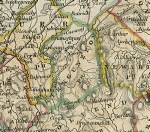The Parish of Kirkgunzeon.
Placenames
The placenames index for this parish is accessed via the menu on the left. Links from there open up access to various historical and modern maps indicating where the place is to be found as well as links to other historical information and photographs if we have them.
References
Extensive historical information, particularly in the form of scanned books, is becoming available on the Internet.
In this section we have begun listing links to this information relative to this parish.
A TOPOGRAPHICAL DICTIONARY OF SCOTLAND, by Samuel Lewis. Published in 2 vols, London, 1846.
"KIRKGUNZEON, a parish, in the stewartry of Kirkcudbright, 9 miles (S. W.) from Dumfries ; containing, with the village of Gateside, 638 inhabitants, of whom 40 are in the village of Kirkgunzeon. This place is supposed to have derived its name, anciently Kirkwynon, from the dedication of its church to St. Wynnin; and this opinion is corroborated by the name of a spring near it, which still retains the appellation of St. Wynnin's well. In the reign of David Bruce, the church and lands belonged to the abbey of Holm-Cultram, in Cumberland ; but in 1369, the abbot, having sided with the English against that monarch, was dispossessed of his property in Scotland. The abbey lands were then conferred by the king upon Sir John Herries, of Terregles, from whose family they passed to the Maxwells, of Nithsdale, whose descendant, Marmaduke Constable Maxwell, of Terregles, Esq., is now the principal proprietor in Kirkgunzeon. The Parish is about five miles in length, and nearly three in average breadth, comprising an area of 7600 acres, of which 5000 are arable, meadow, and pasture, 400 woodland and plantations, and the remainder moor and waste. The surface is irregularly broken into hills of moderate elevation, abounding with grouse and black game. The lower grounds are intersected by a nameless river, which has its source in two lakes in the parish of Newabbey, and, flowing through the centre of this parish, after a course of nine miles, falls into the Urr, about a mile below the village of Dalbeattie. The river abounds with trout, and, in the deeper parts, with perch and pike; and during the spawning season some very large trout, of excellent quality, and weighing from four to six pounds, are taken at the outlets of the lakes in which the stream has its source. Partridges and hares are found in abundance, and occasionally pheasants, but in much smaller numbers.
The ground along the banks of the river is level, and in various other places also flat, and well adapted for the plough ; the soil on these lands is rich and fertile, but of lighter quality on the upland districts. The crops are, barley, oats, and a small quantity of wheat, with potatoes and turnips. The system of agriculture is improved; the farm-houses are substantial and well built, chiefly of granite, and roofed with slate ; the lands are well inclosed, and the fences kept in good repair ; and all the more recent improvements in husbandry are generally practised. The cattle, of which considerable numbers are pastured on the hills, are mostly of the Galloway breed : and Highland bullocks are bought in at Falkirk, at the end of harvest, and during the winter fattened for the markets. Comparatively few sheep are reared ; and on two farms only are shepherds kept to tend the flocks. The plantations, which, within the last few years, have been greatly extended, are in a thriving state. Granite, of which the rocks are principally composed, is the only stone found. The rateable annual value of the parish is £4084.
The village is very inconsiderable, consisting only of a few houses around the church. There is a post-offie at Dalbeattie, about four miles from the village, which has a daily delivery; and facility of communication is afforded by the turnpike-road from Dumfries to Kirkcudbright, which passes through the parish. The Ecclesiastical affairs are under the superintendence of the presbytery and synod of Dumfries. The minister's stipend is £158. 6. 6., of which nearly one half is paid from the exchequer, with a manse, and a glebe valued at £30 per annum ; patron, Mr. Maxwell, of Terregles. The church, situated in the centre of the parish, was erected in 1790, and is a plain neat structure containing 224 sittings. The parochial school is well attended; the master has a salary of £34, with a house and garden, and the fees average £15 per annum. There is also a small school at the lower end of the parish, for which a building was erected by the farmers, at their own expense ; and in addition to the fees, £4 are allowed out of the parochial salary, to the master, who lives by turns with the parents of his pupils. There are still the remains of two ancient houses, formerly seats of the Herrries family, and both of which appear to have been places of strength ; parts are left also of the tower of Drumcoltran. On the farm of Glaisters was a large cairn, of which the stones have been removed for building dykes, and in which were found many urns containing human ashes that crumbled into dust on exposure to the air. A beautiful gold coin of James V., in good preservation, was found some years since on the lands of Lochend; and within the last few years was discovered in the glebe, a silver medal, supposed to have been struck on the dispersion of the Spanish Armada."
